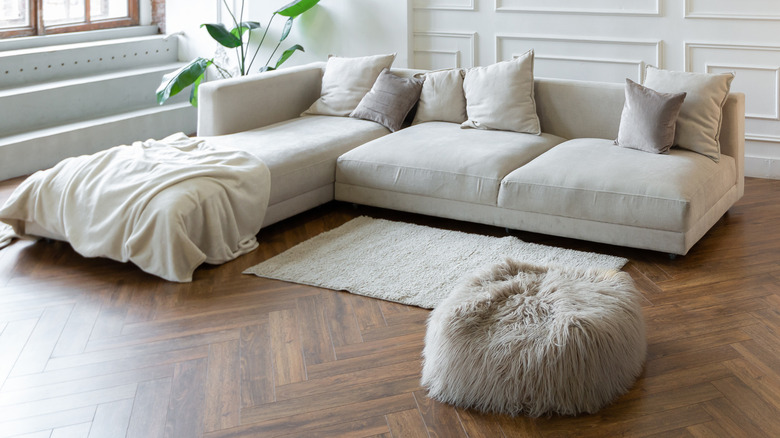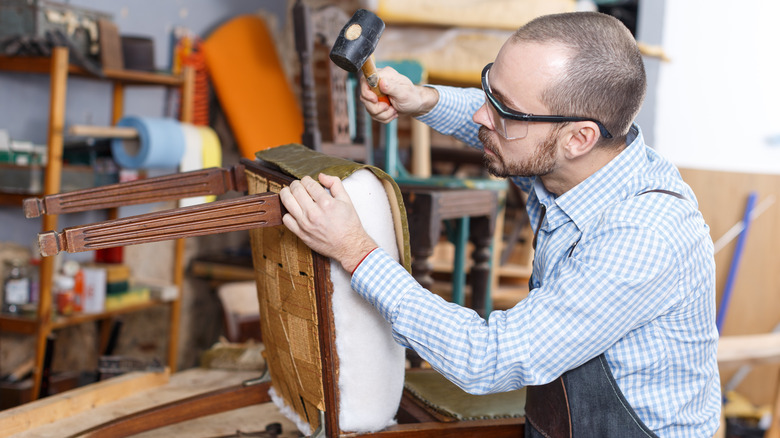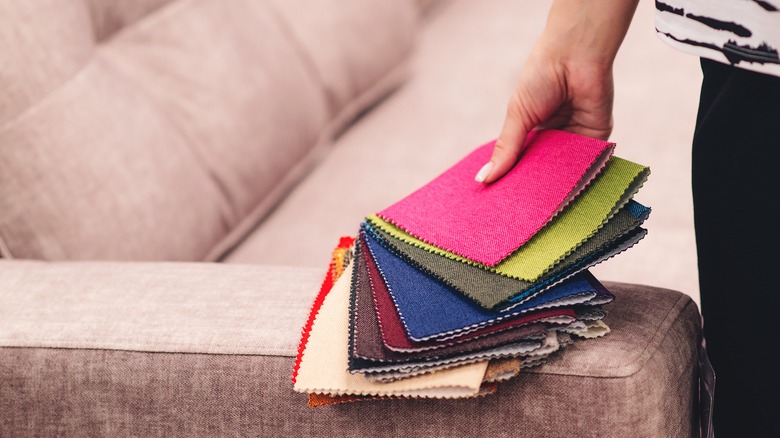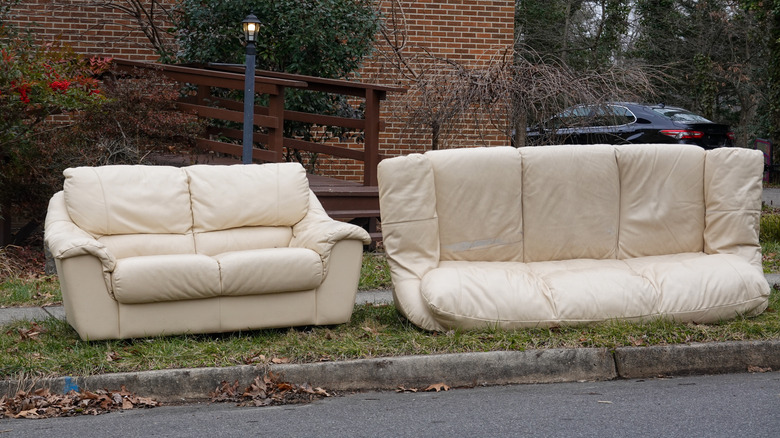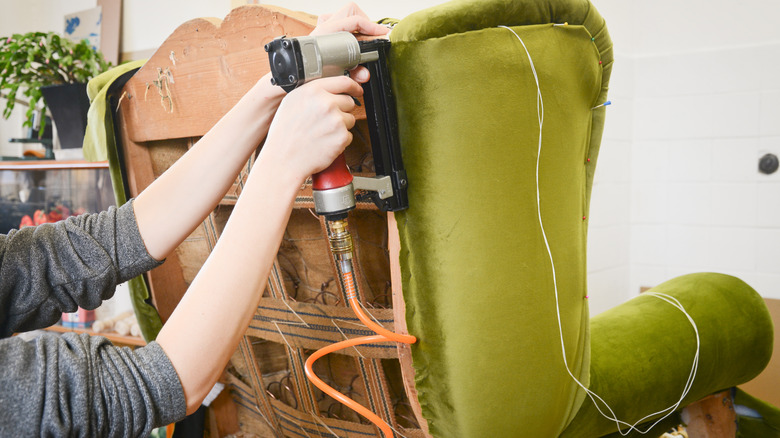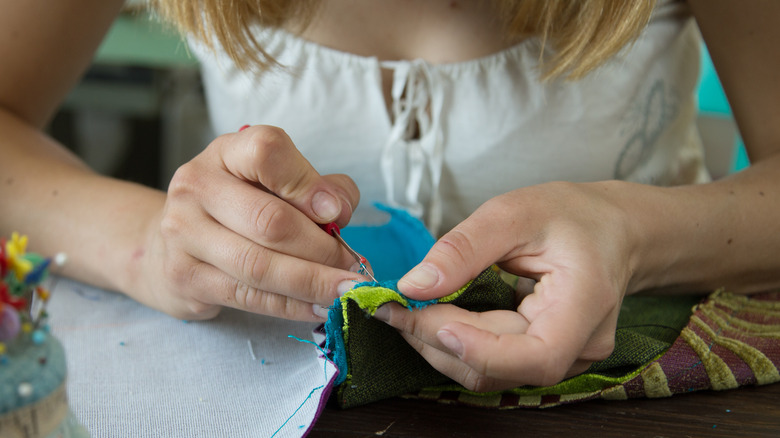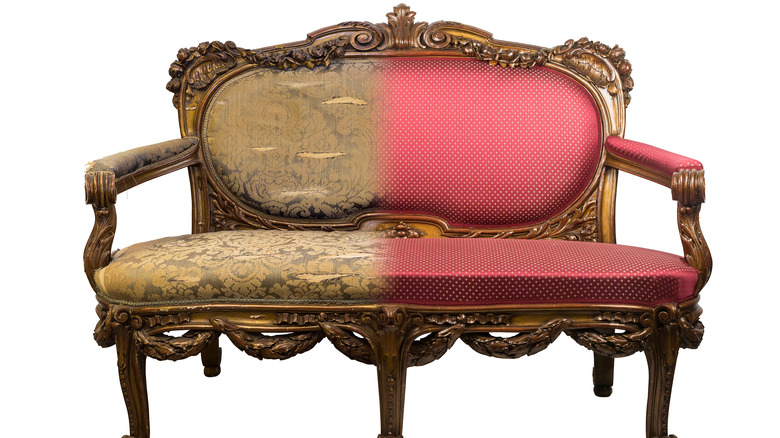What's The Difference? Reupholstery Vs. Recovering
Not many architecture, furnishing, or interior decorating terms are used as inconsistently as the notion of "recovering" furniture. This isn't the product of a misunderstanding or a dispute. People — including professionals — simply use the word to mean different things, all of them perfectly reasonable. So, keeping in mind that it depends on who you're talking to, it would be helpful to figure out what "recovering" furniture is, and how it differs from reupholstery. Recovering is simply putting new fabric directly over the old material on furniture. Reupholstery, on the other hand, is a broader term for various ways of getting new fabric on furniture. That could mean replacing the old covering and the structural pieces underneath, such as layers of polyfoam, batting, or muslin.
Some upholsterers predictably complain about covering one fabric with another, but there isn't necessarily a concrete problem with it. Covering one material with another is a time-honored shortcut in homebuilding and interior decorating. People paper over wallpaper all the time, and roofing can go several layers deep. But there are some potential problems with recovering, so it's worth understanding how it differs from reupholstery. That way, you can decide which option is best for your project.
The upholstery process
The craft of upholstery is more complex than it seems. The upholstery process not only involves removing the old fabric and adding new material to the chair or couch, but it also involves fixing the inner framework, replacing springs, or adding new padding, so the overall shape and structural integrity of the piece are improved.
For example, if you examine the structure of an upholstered chair, you will find many layers beneath the surface working together to create comfortable and attractive cushioning. All these items could be manipulated or changed during reupholstering. Per "The Furniture Bible," you might find layers of cambric, webbing, springs, and burlap in an older piece, as well as all manner of padding materials from horsehair to foam to polyfill batting. This will typically be covered and held together with a layer of muslin or the like, then covered with fabric. The recipe varies by manufacturer, furniture type, the price of the piece, and where the upholstery is found (since covering a seat is a whole different ballgame from covering the back of a chair).
The craft of upholstery is how all of these pieces are assembled to work correctly together. If you thought upholstery was about stapling fabric, you haven't found yourself in the middle of an argument about the virtues of webbing, sinuous spring systems, and eight-way hand-tied springs (via Stylnn). So if a trained upholsterer takes umbrage at the idea that covering the old fabric with new is "reupholstery," it's understandable.
The recovering process
Recovering furniture involves putting new fabric over the existing material of the piece and leaving the internal components alone. In this process, you will not be exposed to any framework or padding because the original upholstery will stay on the couch or chair. That means the furniture item will still retain its internal wear and tear. The sofa might have new fabric, but the cushions might still feel deflated or the springs worn out. You do not tackle those issues with recovering.
The furniture's shape and size indicate how simple a recovering job will be. Ana Verdi of Thompson Fine Home Renovation told Architectural Digest that furniture made entirely of straight lines can be covered by a novice, but "once you get into any sort of curved arm, the process can be trickier if you're not confident making a pleat." That pleat is important because tucking and folding fabric around odd shapes are deceptively tricky and can ruin the effect of a cushioned piece if not done smoothly.
So how is it possible for recovering to be more difficult than replacing upholstery fabric outright? One significant hidden advantage to replacing fabric is that you can use the old fabric as a template for the new, which you can't do without removing it. This is a great boon for the inexperienced; otherwise, one might tend to cut the fabric too large and end up dealing with lumpy folds and bunches of cloth at every corner and turn.
The difference in results
Recovering gets mostly the same quality of results when done by the practiced and skilled. But there are some potential stumbling blocks, and they can be tricky. Perhaps the biggest potential issue with recovering is that when you put fabric on top of fabric, you end up with more fabric. This can cause corner pleats to bulge, create uneven channels in grooved backs, or unevenness in the upholstery. It can also make the piece appear puffier or swollen, and make the transition from fabric to wooden accents (like wooden arms) appear messy.
If odors were part of your motivation for recovering a piece, your project might be doomed from the outset. Porous fabric, which is basically all fabric, isn't going to do much to keep smells from migrating through the new material and straight to your nostrils. This is particularly true of pungent pet odors and, perhaps worst of all, mold, which has an annoying habit of staying alive. Instead of recovering, you would need to reupholster and change out the padding, cushioning, and some of the wood underneath. Because of this, reupholstering should give you a more thorough upgrade.
However, there can be a difference in results if you try to DIY the upholstery process yourself. Since it is more involved and requires you to remove the inside components of a chair or couch, there is more room for error than with recovering. Therefore, the end result might look more amateur than if you stapled new cloth onto the existing fabric.
Reupholstery costs
Before you decide whether to recover or reupholster your piece, and whether to do it yourself, it's probably a good idea to get a handle on what upholstery services cost these days. And hang on to your horsehair, because you might be in for a shock. According to Thumbtack, upholsterers charge between $45 and $100 per hour. You're looking at 12 to 20 hours to reupholster a couch, and perhaps three to eight hours for an ottoman. The fabric itself can cost as much as $40 per yard. When you add it all up, a small loveseat costs about $1,200 on average to reupholster, while a full-size couch averages $3,000 or more. This only increases if there are structural problems or leather to deal with. The hourly repair charges between $45 to $150 per hour, and leather adds about 25% to materials costs and can increase labor expenses. When you start adding decorative tacks, matching throw pillows, and transport fees, you'll soon be thinking about how much you like sitting on the floor.
Chair reupholstering is somewhat less expensive, but then so are chairs. You might pay as little as $500 or as much as $3,500 to reupholster a chair. The huge variation in design and complexity accounts for the variation. Larger chairs are more expensive to cover, and the price also depends on the style of the chair and its condition. You can mitigate these costs by supplying the fabric yourself, using faux leather, choosing a solid-color fabric rather than a patterned one, or by getting a discount for having multiple chairs reupholstered.
Why not just replace the piece?
If all your options either cost more than a new couch, or are noticeably inferior to a new couch, why not just buy a new couch? Well, maybe you should... but there are a few good reasons not to. The National Upholstery Association, while not necessarily a dispassionate participant in such conversations, makes convincing arguments that reupholstering certain pieces makes sense even if it is breathtakingly expensive (not their words). On the altruistic end of things, you would certainly be supporting skilled tradespeople, who bring an understandably pricey mix of labor, skill, math, and art to putting new fabric on your poof.
On top of that, you're keeping your dollars in your local community, at least until your upholsterer pays their student, car, or home loans. And consider the environment: If you think your unupholstered couch looks bad now, think how bad it would look in a local landfill. You can also explore a new hobby or learn a new craft by trying to reupholster or recover a piece yourself.
Recovering - to DIY or not?
Recovering might be acceptable in many situations, but it's not necessarily easy, as we've seen. Many of the same skills used by upholsterers also come to bear in recovering projects. After all, you must shape, attach, and conceal the edges of recovering material. Recovering is popular precisely because reupholstery is a skilled profession and is not the kind of thing you can learn from one 10-minute YouTube video. However, even the most basic recovering job requires some small bit of knowledge if you want to end up with an attractive outcome. Recovering a rectangular padded surface, for example, will still require you to fold the fabric properly in corners. It's not hard, but it's not nothing.
To get a sense of the sort of projects appropriate for a beginner, consider the intro-level projects taught at The Funky Little Chair, like a simple ottoman, dining chair seats, an attached bench seat, and a rectangular (boxed) cushion.
If you're leaning towards going the DIY route, there are a lot of resources available to you online, some friendlier to non-pros than others. You can get casual instruction, formal instruction, hands-on instruction, and ego destruction, all at little or no cost. Practice on thrift-store furniture or a fabric-covered headboard. Look for local courses or opportunities for online learning from organizations like Upholstery Skills Online or Class Central. You might also get help in online forums, which are at least a little more friendly to novices than their counterparts in the computer, plumbing, and electrical industries, though that's not saying much.
Reupholstery - to DIY or not?
While upholstery is a high-skill profession, not everything is as precise as it might seem. If you carefully disassemble an upholstered piece, you'll often find that the cloth tends to be cut roughly and imprecisely. The evidence of this is hidden in skilled tucks and folds, and, in fact, it's simply not necessary to be super-precise in many circumstances. The trick in deciding whether to DIY your reupholstery job is figuring out just how complicated it will be. Can you handle holding the fabric in place with two feet and one hand while you staple with the other hand? Are you going to get too frustrated when the trim no longer fits properly because your pleats ended up a bit untidy? How much frustration and one-handed stapling can you buy for $3,000? Only you can really say.
This is not to imply that you can do it if you put your will to it. That is undoubtedly true, but you might also have to put your calendar to it. If you think you can quickly learn a skilled trade at the University of YouTube the night before you start ripping that Queen Anne chair apart, well... let's just hope you're right, or that you own some other chairs.
Rest Less claims that many upholstery projects are easier than they appear and can be as simple as wrapping a present ... to your newly invigorated self! But silliness aside. Rest Less makes a good case: learn the basics, get some good tools, learn some more, and then some more. Then try some upholstery. Among its recommendations is Sailrite, a sewing tools manufacturer with a great YouTube channel for DIYers.
When to recover versus reupholster
How do you ultimately decide whether to recover or reupholster, whether you're doing the work yourself or not? It basically comes down to the complexity of the job and the value of the piece to be spruced up. A piece with a lot of sentimental value might demand the more thorough treatment of reupholstering, according to Thumbtack. It might also be worthwhile if the piece you're reworking has good resale value prospects, including well-made pieces that use higher-quality materials, especially wood. Heft and age are other clues that you might be making a reasonable investment by reupholstering.
But recovering it might make sense if you can't afford such an investment, and if the piece is comparatively simple and can be completed by a novice or a pro in a reasonable amount of time. Just be particular, be clear about your goals, and keep an eye on that fabric threatening to bunch up in the corners.
